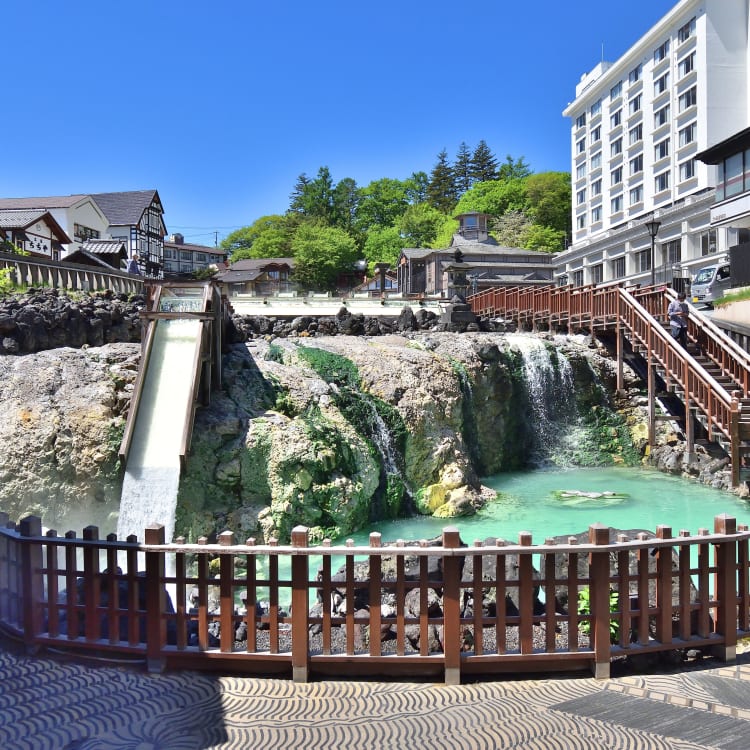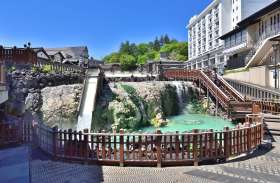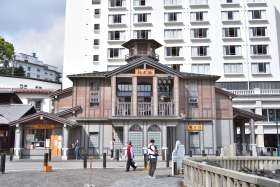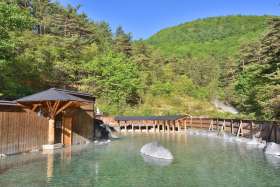
Story
Cooling hot thermal waters with paddle and song
Experience the Edo tradition of yumomi
By JNTO On 6 January 2022
With thousands of hot spring towns spread across Japan, a handful of them stand out from the crowd for their uniqueness. One of these is Kusatsu, a small hot spring town located in landlocked Gunma Prefecture, which is accessible from Tokyo in around 3 hours by train and bus.
Kusatsu Onsen, located at altitude of 1,200m within the Joshintesu Kogen National Park, is fed copious amounts of mineral-rich volcanic water from nearby Mt. Shirane, an active volcano. This abundance of mineral water is fed into the town’s most signature attraction: the yubatake, or hot water field, which sits in the centre of town.


With 5,000 litres of thermal water produced every minute, Kusatsu boasts the largest water output of any Japanese hot spring. But the water at this stage is too hot for bathing, so long wooden troughs called mokuhi channel the 70ºC water into a blue pool at the bottom, allowing it to cool naturally before it is sent to various hot spring resorts around the town.


While the yubatake is a major attraction in Kusatsu, there is another draw that is unique to the town: the Netsu no Yu bathhouse. Located next to the yubatake, the bathhouse holds the daily yumomi ritual.
Netsu no Yu’s Yumomi performance
One of the major reasons Kusatsu draws about 3 million visitors annually is not just to relax in its geothermal hot springs. Many come to witness the yumomi ritual – a traditional song and dance performance in which the very hot bath water is beaten with wooden paddles to cool it down. It is a ritual that has been performed since the Edo period centuries ago.
The reason for this ritual is because at up to 90°C, the hot spring water direct from the source is too scalding hot to bathe in. The yumomi method cools the water down without needing to add cold water, which would dilute the natural minerals present.
Open to the public, the half-hour yumomi performance is carried out by a troupe of locals who incorporate traditional folk songs and dance into the process. A classic yumomi is performed by up to 10 female performers; 5 on each side of the hot spring pool, each armed with a 180cm-long wooden paddle.


The water is cooled by stirring and slapping the paddles in the water to the rhythm of the songs, splashing water in the air to cool it. In addition to making the hot spring water an optimal temperature, the act of stirring also distributes the mineral elements evenly, so it feels soft on the skin.
While the yumomi is usually performed by traditionally-dressed women, called yumomi musume, there are now some shows featuring young men called yumomi-kun, who are actually part of the local professional soccer team. Dressed in happi coats and shorts, these energetic “macho” yumomi shows are performed several times a month.
*Currently closed as of January 2022. Please refer to the website for more information.


The audience can watch the yumomi from either the ground level or the first floor balcony. During the performance, some audience members are sometimes allowed to partake in the stirring. Performances take place six times a day for a small fee.
After witnessing the yumomi, you can experience the results of this ritual at one of Kusatsu Onsen’s many ryokan guesthouses with in-house hot springs. Gozanoyu is famous for its large, traditional wooden bathtubs, while Sainokawara Rotenburo features a large open-air bath with gorgeous forest views, and the Otakinoyu boasts a large indoor pool with hillside views. You can also dip your foot at the free footbath near the yubatake, or at any of the 13 free public onsen fa facilities scattered around town.
Netsu no Yu Yumomi performance
Address: 414 Kusatsu, Agatsuma District, Gunma 377-1711
Fees: 600 yen (adult)
Show times: 9:30am, 10:00am, 10:30am, 3:30pm, 4:00pm, 4:30pm
Website: kusatsu-onsen.ne.jp
















































